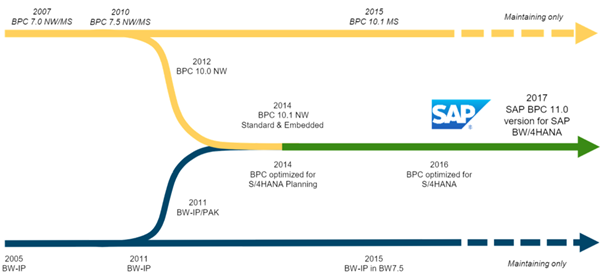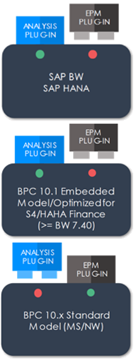EPM and Analysis plug-ins Compared – Critical information for the BPC v10.1 embedded, v10.1 and v11x user.
Since the last blog published on the differences between the EPM and Analysis plug-ins here (https://www.column5.com/blog/epm-vs-analysis-office), SAP has carried out much development activity on the Analysis for Office add-in, which is currently (October 2018) at version 2.7. As many clients are moving along the SAP roadmap towards SAP BPC 11, the necessity to review and understand the functionality offered by the Analysis for Office Add-in and its two components, the EPM and Analysis plug-ins, has become more urgent.

Source: SAP
This blog will set out to compare the functionality between the EPM and Analysis plug-ins as it currently stands at version 2.7 of the Analysis for Office Add-in.
Which Plugin to use?
Before we start on the functionality comparison it is worthwhile to point out that your choice of which plugin to use is not free, you are constrained by the source system that you want to read data from.
- To read directly from the SAP Hana or BW data layers only the Analysis Plug-in should be used.
- To read data from any BPC embedded version only the Analysis Plug-in should be used.
- To read data from any Standard version of BPC, in either its Microsoft or NetWeaver versions, only the EPM Plug-in should be used.
This is a very important question when upgrading to a new version of BPC and making the decision to choose between the Standard or Embedded BPC versions, because that choice also implies choosing between Analysis and EPM plug-ins. This is because the skill-set is slightly different. If you are upgrading from a standard version using EPM then some retraining will need to be done on Analysis if this skill does not already exist in-house and there will be a change management challenge for all those users who have become familiar with EPM Reporting. Not an insurmountable challenge but one you really need to be aware of.
If you are using a Standard BPC NetWeaver version reading from a BW data source then you have the option of using the Analysis plug-n to read from the BW data layer and the EPM plug-in to read from the BPC data. This can be very useful in many circumstances but in particular for creating reconciliation reports, as Analysis and EPM reports can be combined in the same Excel Workbook sourcing BPC and BW data and making comparison reports simple to create.
Key Points of comparison
Here are some of the key points of comparison. There are many differences and our experts would be happy to take you through them but take note of these as a starting point:
- Creation of ad-hoc reports by drag and drop Both Analysis and EPM offer drag and drop ad-hoc report creation.
- Report execution performance when large volumes of data are involved
High-speed data retrieval is superior in Analysis. When data volumes are very large EPM performance is not optimal.
- Report integration with SAP Lumira for corporate reporting and dashboarding
Analysis is integrated with Lumira, EPM is not.
- Speed and efficiency of creation of reports
Analysis requires BEx queries* to be created as opposed to drag-and-drop in EPM. This means that users need to know how to write BEx queries, which is a whole new world for many finance users coming from a BPC standard background, and it means that it takes longer to create an Analysis Report or Input Form due to this additional programming step.
- Skilled resources, educational material, and extensive trouble shooting available
Both Analysis and EPM have a large pool of skilled resources available, along with educational and troubleshooting material.
- Integration with other components of BPC (planning functions/DM packages etc.)
Execution of allocations and other similar business logic on an ad-hoc basis has deep integration with the Analysis plug-in. With EPM, the integration is weak and more error prone.
- SAP’s focus and investment
The SAP roadmap foresees Analysis as the single add-in going forward. This means that if you invest in upskilling to Analysis now you won’t need to do it again in the future.
- Formatting of a report with in-built features
Both Analysis and EPM enable users to format reports and input Forms with in-built features, although the approach is different (the EPM formatting sheets do not exist in Analysis).
- Member recognition (ability to type in a characteristic value in an Excel spreadsheet to retrieve relevant data)
EPM has true member recognition whereas Analysis does not, it utilizes drag and drop functionality through a filter pane.
- Axes sharing (ability to integrate multiple data sources)
Both Analysis and EPM plug-ins allow multiple sources of data to be grouped/combined for analysis purposes. E.g.: Data Reconciliation
- Comments functionality
The ability to add comments linked to data is now available in Analysis 2.7 and BW/4HANA). Previously this was only available in the EPM plug-in.
- Formulas on data cells
Both Analysis and EPM plug-ins allow users to put formulas into cells that form part of the data retrieval grid
- Access to dimension member properties/attributes during analysis (pivot table, slice/dice, restrictions, and filtering)
Ad-hoc analysis is simpler with the Analysis Plug-in as it has easier access to these features than EPM.
- EPM functions vs SAP formula
All key EPM functions such as SAPGETDATA are available in the form of SAP formulas for Analysis. Others are being developed although EPM still has more currently available.
- Filter by Measure
Both Analysis and EPM plug-ins offer the ability to filter data cells based on a threshold value.
- Business Process Flows
Both Analysis and EPM plug-ins can be launched from Business Process Flows.
- Granular security (ability to integrate deeply with BW security)
Analysis for office offers greater integration with BW security.
- Configuration and maintenance of prompts (merge prompts with other reports in the workbook etc)
Both Analysis and EPM require users to enter prompts to retrieve data. However, prompts are configured differently in each plug-in and analysis requires BEx queries to be programmed to support the use of prompts.
- Locking
Both Analysis and EPM offer locking by Entity, Period and Category.
- Copying reports across tabs
Both Analysis and EPM allow users to copy reports across tabs.
- Undo and redo functionality
‘Undo’ and ‘Redo’ functionality exists in Analysis, however, EPM does not have ‘redo’ functionality.
- Customising totals and sub-totals
It is easier to customise totals and subtotals in Analysis than in EPM. Because customised totals and subtotals are added through the EPM report writer using local members. With Analysis plug-in it is just a switch.
- VBA to customize reports
Visual basic can be used to customize reports in both Analysis and EPM.
Conclusion
Your choice of BPC software versions is influenced by many factors but we all know the success of projects is very much driven by end user perception and acceptance of reporting tools, so understanding the differences between Analysis and EPM plug-ins is one key point of consideration. Clearly there are more challenges for users moving from BPC standard to AO than those who are moving from BW IP. But to be forewarned of the differences and the challenges as well as new opportunities AO brings will help you to make your project a success. Hopefully this blog has clarified some of the questions you may have.
There are many more items we could have covered in detail in this blog, but we plan to publish a follow up, based on our experiences, in the next couple of months. In that we will look more closely at issues such as SAP formulas compared with EPM functions, so make sure you register for blog notifications to get the next update.
If you have further questions about BPC upgrades, or Analysis and EPM plug-ins, contact one of our Column5 experts to discuss options and to learn from our experiences.
Authors:
Richard Hynes – Senior Consultant
Surya Tamada – Principal Consultant BPC Embedded Centre of Excellence
*BEx Queries
BW/BI Business Explorer (BEx) is a suite of tools used to create ad hoc queries and perform analysis of query results. BEx Query Designer and BEx Query Analyzer are the two basic tools required for creating and analyzing ad hoc queries.










